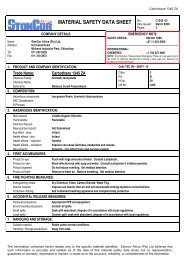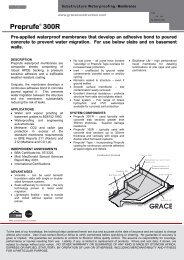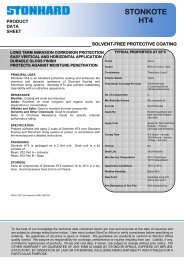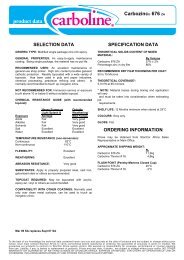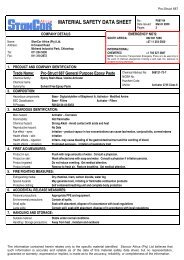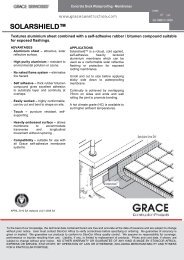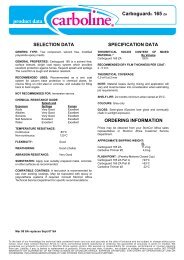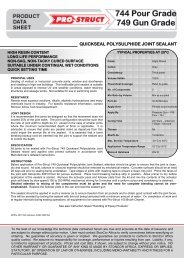product data - StonCor Africa
product data - StonCor Africa
product data - StonCor Africa
You also want an ePaper? Increase the reach of your titles
YUMPU automatically turns print PDFs into web optimized ePapers that Google loves.
APPLICATION INSTRUCTIONS<br />
These instructions are not intended to show <strong>product</strong> recommendations for specific service. They are issued as an aid in determining correct surface<br />
preparation, mixing instructions and application procedure. It is assumed that the proper <strong>product</strong> recommendations have been made. These<br />
instructions should be followed closely to obtain the maximum service from the materials.<br />
SURFACE PREPARATION: Remove any oil or grease from<br />
surface to be coated.<br />
Concrete floors should be at least as rough as medium grit<br />
sandpaper. The surface should be free of laitance. This can be<br />
accomplished by acid etch or mechanical abrasion. Do not coat<br />
concrete floors treated with hardening solutions unless test<br />
patch indicates satisfactory adhesion. Do not apply coating<br />
unless concrete has cured at least 28 days @ 25°C and 50%<br />
R.H.<br />
MIXING: Mix to smooth consistency before thinning. Thin 25%<br />
by volume with Carboline Thinner # 10 for first coat. Apply<br />
second coat undiluted.<br />
APPLICATION TEMPERATURES:<br />
Material<br />
Surface<br />
Normal 18-29°C 16-29°C<br />
Minimum 10°C 10°C<br />
Maximum 38°C 38°C<br />
Ambient<br />
Humidity<br />
Normal 10-32°C 35-80%<br />
Minimum 10°C 10%<br />
Maximum 43°C 90%<br />
Do not apply when the surface temperature is less than 2°C<br />
above the dew point. Special thinning and application<br />
techniques may be required above or below normal condition.<br />
SPRAY: Use adequate air volume for correct application. Hold<br />
gun 200-250 mm from the surface and at a right angle to the<br />
surface.<br />
Use a 50% overlap with each pass of the gun. On irregular<br />
surfaces, coat the edges first, making an extra pass later.<br />
NOTE: The following equipment has been found suitable,<br />
however, equivalent equipment may be substituted.<br />
CONVENTIONAL: Use a 10 mm minimum I.D. Material Hose.<br />
Mfr. & Gun Fluid Tip Air Cap<br />
Binks # 18 or # 62 63B 63PB<br />
DeVilbiss P-MBC or JGA FX (Approx. .043 ID) 704<br />
AIRLESS: Use a 10 mm minimum I.D. Material Hose.<br />
Mfr. & Gun<br />
Pump*<br />
DeVilbiss JGB-507 QFA-514<br />
Graco 205-591 President 30:1 or Bulldog 30:1<br />
Binks Model 500 Mercury 5C<br />
* Teflon packings are recommended and available from<br />
pump manufacturer.<br />
Use a 0.015" tip with 2000 psi. (138 Bar)<br />
BRUSH OR ROLLER: Brush or spread using long even<br />
full strokes. Avoid rebrushing. Rollers should be medium<br />
nap mohair or lint free lambs wool. Use slow even strokes<br />
with maximum amount of thinner to avoid air entrapment.<br />
Avoid rerolling.<br />
NON-SKID SURFACE: Broadcast Non - skid grit into the<br />
second-to-last coat of Carbothane 1345 ZA. Apply a full<br />
coat of Carbothane 1345 ZA over the silica for ease of<br />
cleaning.<br />
DRYING TIMES:<br />
Between Coats Final Cure<br />
@ 50% R.H.<br />
@ 50% R.H.<br />
12 hours 10°C 48 hours<br />
8 hours 16°C 36 hours<br />
6 hours 24°C 24 hours<br />
4 hours 32°C 18 hours<br />
NOTE: If more than 12 hours @ 25°C or equivalent time<br />
has elapsed between coats, special surface preparation<br />
will be required.<br />
CLEAN UP: Use Carboline Thinner # 10<br />
STORAGE CONDITIONS:<br />
Temperature:<br />
4-43°C<br />
Humidity: 0-95%<br />
For more detailed information please consult specific<br />
Carboline Application Guides<br />
CAUTION: MAY CONTAIN FLAMMABLE SOLVENTS. KEEP AWAY FROM SPARKS AND OPEN FLAMES. IN CONFINED AREAS WORKMEN MUST WEAR<br />
FRESH AIRLINE RESPIRATORS. HYPERSENSITIVE PERSONS SHOULD WEAR GLOVES OR USE PROTECTIVE CREAM. ALL ELECTRONIC<br />
EQUIPMENT AND INSTALLATIONS SHOULD BE MADE AND GROUNDED IN ACCORDANCE WITH THE NATIONAL ELECTRICAL CODE. IN AREAS<br />
WHERE EXPLOSION HAZARDS EXIST, WORKMEN SHOULD BE REQUIRED TO USE NONFERROUS TOOLS AND TO WEAR CONDUCTIVE<br />
AND NONSPARKING SHOES.<br />
An<br />
Company<br />
<strong>Africa</strong><br />
<strong>StonCor</strong> <strong>Africa</strong> (Pty) Ltd<br />
Co. Reg. No.: 1996/01848/07<br />
Tel No : +27 11 254 5500<br />
Website: www.stoncor.co.za<br />
E-mail: stoncorsa@stoncor.com





